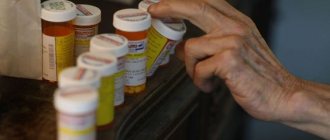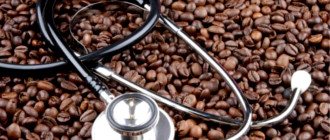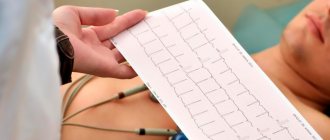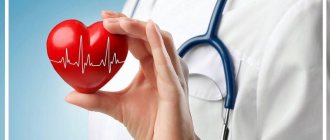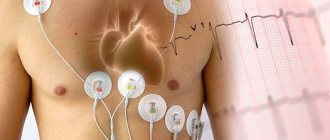Author
Pavlyuchenko Nadezhda Sergeevna
Senior doctor
Cardiologist
until November 30
We are giving away 1000 rubles for all services for a visit in November More details All promotions
Treadmill test
is a stress test that allows you to determine how a person’s heart reacts to physical activity. At its core, the treadmill test is an electrocardiographic study that is performed during physical activity. To create physical activity, a special treadmill is used - a treadmill (hence the name of the test).
How is the treadmill test performed?
Treadmill test
The patient is asked to walk on a treadmill, while the parameters of its movement change: every three minutes the speed and inclination of the treadmill increase.
The examination is carried out by a functional diagnostics doctor. The following data is recorded: ECG, blood pressure (blood pressure), pulse oximetry (blood oxygen saturation), heart rate (heart rate). These data are taken before the test, while on the treadmill and at the end of physical activity.
The results of the treadmill test allow you to determine the degree of tolerance to physical activity, as well as the threshold at which signs of the disease begin to clearly appear.
It is very important that the specialist conducts professional supervision in compliance with all necessary precautions, which is guaranteed to protect you from possible complications.
You can do a treadmill test in Moscow at JSC “Family Doctor”.
Contraindications
The treadmill test is of great diagnostic value for identifying a number of heart diseases , clarifying the diagnosis when the results of conventional electrocardiography are low, and assessing the effectiveness of prescribed therapy. At the same time, there are a number of pathologies for which the treadmill test is prohibited. Among them are recent acute myocardial infarction, severe heart failure, and severe vascular changes. Due to serious risks, treadmill testing is necessarily preceded by a comprehensive examination using safe techniques.
Preparing for the treadmill test
Before performing the treadmill test you will need:
- get advice from a therapist (general practitioner) or cardiologist;
- do an ECG.
The last meal should be no later than 4 hours before the test. The day before the treadmill test, it is necessary to stop taking medications such as beta blockers and nitrates.
To take the test, you will need cotton socks and comfortable clothing that will not restrict your movements.
Are there possible complications during the procedure?
The body of any patient is unpredictable, so complications can arise during any study. When performing this test, the risk of complications is extremely low, which is why the treadmill is used so widely. However, the physician conducting the test should carefully review the patient's medical history before the test and observe the patient extremely closely while walking on the treadmill.
In rare cases, a patient may experience an acute heart attack, hypertensive crisis, acute cardiac arrhythmias, pulmonary embolism, or acute heart failure (pulmonary edema) during a stress test. In addition, the patient may lose consciousness at the height of the load.
Indications for treadmill test
The treadmill test is carried out in the following cases:
- with pain of an uncertain nature in the chest and behind the sternum;
- in order to determine exercise tolerance (i.e. resistance to stress, endurance);
- when assessing professional suitability (for work in extreme conditions or under conditions of increased physical stress);
- patients with arterial hypertension (a sharp increase in blood pressure indicates belonging to a risk group for hypertension);
- for the purpose of detecting and identifying heart rhythm disturbances;
- patients with hypercholesterolemia (high cholesterol in the blood) to identify “hidden” insufficiency of the blood supply to the heart;
- to identify “hidden” (“silent”) episodes of insufficient blood supply to the myocardium (diagnosis of coronary artery disease and other heart diseases);
- patients diagnosed with coronary heart disease (CHD) in order to determine individual tolerance (tolerance) to physical activity (determination of the functional class (FC) of angina pectoris);
- for the purpose of selecting and assessing the effectiveness of treatment and rehabilitation measures in patients with coronary artery disease, including after myocardial infarction;
- as part of the examination of the working capacity of patients with cardiovascular diseases.
Pedal! What is bicycle ergometry?
Have you visited a cardiologist and he directed you to do bicycle ergometry? What is this procedure? Why is it needed?
Our questions are answered by Anna Stefanovna Zimoglyadova, functional diagnostics doctor at Clinic Expert Stavropol.
— Anna Stefanovna, when it comes to studying the heart, methods such as, for example, ECG, Holter, ultrasound of the heart (echocardiography) are often mentioned. What is bicycle ergometry?
— This is also one of the methods of functional diagnostics. Bicycle ergometry is a test with dosed physical activity and simultaneous recording of an electrocardiogram, blood pressure and pulse. The study is carried out on an exercise bike equipped with special sensors.
— In what cases does the doctor recommend doing bicycle ergometry? What are the indications for this study?
— Since this method makes it possible to detect hidden coronary insufficiency and heart rhythm disturbances, the indication for bicycle ergometry may be, for example, a suspicion of an asymptomatic form of coronary artery disease (coronary heart disease) or heart failure. This method allows you to assess the degree of resistance of the body to stress in case of angina pectoris, congenital and acquired heart defects, as well as arrhythmias, including those that occur after physical activity. Bicycle ergometry will be useful for dynamic monitoring and assessment of the work capacity of patients who have suffered a myocardial infarction and heart surgery, as well as for those who are at risk for developing coronary artery disease (patients over 40 years of age, drivers, pilots, divers).
The results of this study may be valuable for clarifying the diagnosis of shortness of breath of unknown etiology (cause). In addition, this method is widely used in the sports environment to determine a person’s readiness to engage in a particular sport and to assess his endurance.
I would like to note that functional diagnostic methods always complement each other, so bicycle ergometry is usually carried out in combination with electrocardiography (ECG), Holter (Holter ECG monitoring), and ultrasound examination of the heart. Analysis of the totality of the results of these studies can help a specialist make the correct diagnosis.
Read materials on the topic:
Coronary heart disease: diagnosis and treatment How to prevent myocardial infarction? Recognizing a heart enemy. What is arrhythmia? No more sentence! Congenital heart defects in children: identify and treat Shortness of breath: when does the body ask for help?
— Is it necessary to prepare for bicycle ergometry? If so, how?
— There is no specific preparation, but some requirements must be followed before the procedure. So, for example, 12-24 hours before the diagnosis you will have to give up cigarettes, caffeine-containing drinks, and alcohol. It is recommended to eat no later than 3 hours before the procedure. Moreover, food should be easily digestible.
If the patient takes any medications on an ongoing basis, it is recommended to discuss their impact on the diagnostic results with the attending physician before performing bicycle ergometry.
— How is this procedure carried out?
— To perform bicycle ergometry, an exercise bike with built-in sensors is used. They also connect to the patient. Before starting the study, the doctor takes readings of the ECG, blood pressure and resting pulse. Then the patient sits on the simulator, pedals and describes his condition under various loads. The average rotation speed is 1 revolution per second. Every 3 minutes the doctor increases the load. In this case, all changes in heart rate, blood pressure, and pulse are recorded in the protocol.
There are various options for conducting the study: with a constant load, in intermittent mode, with a continuously increasing load. The doctor chooses one option or another based on the purpose of the study and the individual characteristics of the patient.
I would like to emphasize that despite the apparent simplicity of the procedure, it is necessary to carefully monitor the patient and his performance. If the patient complains of feeling unwell, chest pain, shortness of breath, the procedure is stopped. We do the same if the sensors show signs of incipient ischemia and blood pressure rises. If the patient feels well and all indicators are within acceptable limits, the study is continued until the heart rate reaches 85% of the acceptable values.
After this, the doctor analyzes the data obtained in a special program and draws up a conclusion.
— How long does bicycle ergometry last?
- On average 10-15 minutes.
— Anna Stefanovna, please tell us about the existing contraindications to bicycle ergometry
- There are quite a lot of them. First of all, these are diseases in the acute period (for example, strokes and heart attacks), unstable angina, severe arterial hypertension and hypotension, congestive heart failure, aneurysms of large vessels, the presence of blood clots in the cavities of the heart or in the pulmonary artery, pneumonia. The procedure is also not performed in case of fever, acute infectious diseases, or mental disorders.
Read materials on the topic:
Speculation about hypertension When there is nowhere lower. We understand the causes of hypotension. Find and neutralize. How to protect against blood clots? Thromboembolism: how to prevent trouble?
— What is a treadmill test? Is this the same as bicycle ergometry? If not, what are the differences and similarities between these methods?
— The treadmill test is a kind of analogue of bicycle ergometry, but it is carried out not on an exercise bike, but on a treadmill. This, in fact, is the difference between these methods from each other.
The patient moves on a treadmill, which gradually changes incline and speed. As with bicycle ergometry, throughout the entire procedure the doctor pays attention to the patient’s appearance and well-being and monitors indicators from sensors so as not to miss alarming symptoms.
— Do you always need a doctor’s referral to sign up for bicycle ergometry?
— Yes, a doctor’s referral is required, since this procedure cannot be performed on all patients. In addition to the referral, an electrocardiogram is required, and the results of 24-hour blood pressure and Holter monitoring may also be required.
— Is bicycle ergometry performed for children?
- Yes, from the age of 6. This age limit is due to the fact that the child must consciously approach the procedure, understand the doctor’s instructions and be able to assess his condition.
Interviewed by Sevilya Ibraimova
You can sign up for bicycle ergometry here. ATTENTION: the service is not available in all cities
The editors recommend:
What does an electrocardiogram reveal? Holter (24-hour) ECG monitoring – complete instructions for the patient What will a heart ultrasound tell you? When is daily blood pressure monitoring prescribed? Breathe deeply! Who can benefit from spirometry?
For reference:
Zimoglyadova Anna Stefanovna
In 2012 she graduated from the pediatric faculty of the Stavropol State Medical Academy. In 2013 - internship in the specialty "Pediatrics". In 2021, she underwent professional retraining in functional diagnostics. Since 2021, he has been working as a functional diagnostics doctor at the Expert Clinic in Stavropol. Receives at the address: Stavropol, st. Dovatortsev, 39A.
Results and transcript
In our medical center you can undergo a treadmill test with a load in Moscow quickly and inexpensively. Within half an hour, patients receive test results and an ECG with a specialist’s conclusion, which is included in the price of the study.
If rhythm disturbances and ischemic changes are detected, additional examinations are prescribed - ultrasound of the heart, laboratory diagnostics. With the results, you can contact a doctor at our clinic, who will interpret the cardiogram, make a diagnosis and prescribe treatment.
Features of diagnostics
The treadmill stress test allows you to evaluate the work of the heart under load, with accelerated blood flow and increased contraction frequency.
To test, electrodes are attached to the body, through which the doctor monitors cardiac activity. Blood pressure is also continuously measured during the test.
The first stage of diagnosis involves walking. After 2-3 minutes the load increases - the speed increases or the angle of elevation changes. The load is dosed depending on the patient’s condition and indications. Heart function indicators are recorded on an electrocardiogram. Based on the goals of the study, the doctor can conduct a stress test on a treadmill, bicycle ergometry, and testing with a gas analyzer.
The examination is stopped in the following cases:
- achieving the parameters required for the study;
- achieving the required contraction frequency (the doctor determines it individually);
- the appearance of complaints of deterioration in health, which may be evidence of ischemia.
Material and methods
The study was carried out on 107 patients on a treadmill (average age was 52.5 years, men - 74.6% and women - 25.4%) and 108 patients on VEM (average age was 49.4 years, men - 76.8% and women – 23.2%). NP on the treadmill was carried out according to the protocol of Bruce and mod. Bruce, NP on VEM was carried out according to the 50+25 and 25+25 protocol. The ECG was monitored in 12 standard leads, blood pressure was monitored at baseline, at the 2nd minute of each load step and at every minute of the recovery period. Upon completion of the load as a result of achieving a submaximal heart rate without electrocardiographic and clinical signs of angina, the test was regarded as negative.
If atypical discomfort in the chest appeared during exercise without ECG signs of myocardial ischemia, as well as ST segment depression of 1 mm or more in people with a low pre-test probability of coronary artery disease, the test was regarded as doubtful. A test terminated as a result of fatigue when submaximal heart rate was not achieved in the absence of clinical and ECG signs of myocardial ischemia was considered incomplete. Horizontal or other ST segment depression of 1 mm or more in individuals with an average or high pre-test probability of CAD was considered a positive test. The results of the study are presented in the table .
